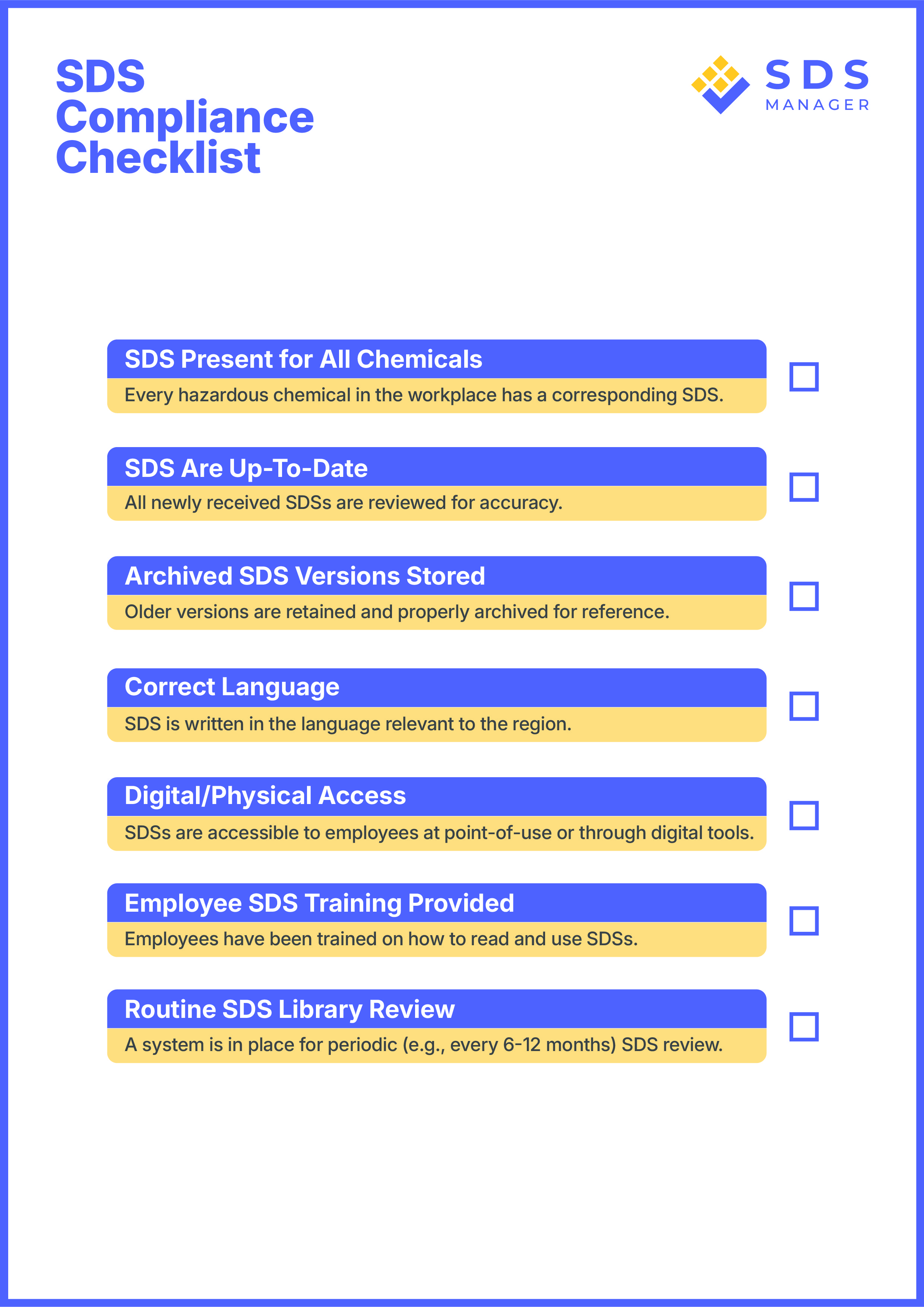

As regulations evolve and workplace safety expectations rise, the role of health and safety managers is more critical than ever. One of the foundational pillars of chemical safety is proper management of Safety Data Sheets (SDS). But staying compliant in 2025 isn’t just about collecting documents, it’s about making sure they’re accurate, accessible, and part of a proactive safety culture.
1. SDS Present for All Chemicals
Every hazardous chemical in your workplace, whether it's in use or in storage, must have an SDS. This is the first and most essential step in compliance. If a product arrives without one, contact the supplier immediately. You can also use our Free SDS search tool to find the SDS you need.
2. SDSs Are Up-To-Date
When a new SDS arrives, always check the revision date to ensure it reflects the most recent version. Regulations and formulations can change, so it’s important to confirm that you're working with the latest information. If the SDS is outdated or doesn’t show a clear revision date, reach out to your supplier for clarification or an updated version. Staying current supports compliance and protects your team.
3. Archived SDS Versions Stored
It’s important to keep records of previous SDS versions, especially if a product has changed over time or no longer used on-site. Archived SDSs are primarily needed because OSHA requires them to be retained for 30 years to document potential employee exposure to hazardous substances. Archiving old SDS versions ensures your company stays OSHA compliant and is able to provide documentation in case of audits or employee exposure investigations. Store these records securely either in physical form or through a digital SDS management system so they’re accessible when needed.
4. Correct Language
SDSs must be available in a language that your employees can understand. In U.S. workplaces, this usually means English, but if your team includes employees who primarily speak Spanish or another language, it's your responsibility to ensure that SDSs are provided in those languages as well. OSHA’s Hazard Communication Standard requires that safety information be clearly communicated to all workers, so having SDSs in the correct language is not just best practice, it’s a compliance issue.
5. Digital or Physical Access Provided
SDSs must be easy to access for employees, especially at the point of use. Whether that means having printed copies near workstations or using a QR code system that links to digital files, the key is that workers can find and read the documents without delay. Accessibility is a core part of regulatory compliance.
6. Employee SDS Training Provided
Having SDSs on hand isn’t enough, employees must be trained to understand and use them. That includes recognizing hazard information, following safe handling procedures, and knowing what to do in an emergency. Training should be provided during onboarding, when new chemicals are introduced, and as part of regular safety refreshers.
7. Routine SDS Library Review
A best practice is to review your SDS collection every 6 to 12 months. This ensures that all documents are still up-to-date, and aligned with your chemical inventory. It also helps you identify outdated products or chemicals no longer in use. Regular reviews are one of the simplest ways to stay audit-ready. Be sure to mark the latest review date.
Your Go-To SDS Compliance Checklist
To simplify SDS compliance, we’ve created a comprehensive checklist. Whether you’re updating your chemical safety program or prepping for an audit, this checklist keeps you organized and compliant. Download the image below for quick reference.
Compliance Is Culture
SDS compliance isn’t just about meeting legal requirements, it’s about creating a safer, more reliable workplace where employees feel valued and protected. Keeping your safety data sheets accurate, up to date, and easy to access helps teams respond quickly to spills, choose the right protective gear, and make smart decisions during emergencies. When everyone understands how to use these documents, safety becomes a shared responsibility, not just a management task. A well-managed SDS system shows your commitment to health, safety, and a culture of care.

How SDS Manager Can Help
SDS Manager is designed to help safety managers stay on top of their SDS responsibilities with tools that align closely with the checklist above.
- Multilingual Access & QR Codes: Provide SDSs in multiple languages with instant mobile access via QR codes.
- Automated SDS Updates: Always stay compliant with the latest SDS versions, automatically sourced from manufacturers.
- One click access to safety information: Safety information is instantly accessible, with hazard details, PPE icons, first aid information, precaution against accidental spills and more. Additionally, a Safety Information Summary can be generated to give employees the essential guidance they need when handling chemicals.
- Generate Secondary container labels: Generate secondary container labels in 15 sizes. Labels feature QR codes, crucial H- and P-codes, and PPE icons.
Getting Started Is Easy
Whether you're building your SDS library from scratch or upgrading your current system for better compliance in 2025, SDS Manager makes the process simple and stress-free. Here's how you can take the next step toward streamlined chemical safety:
- Contact Us For Free Setup Support
- Uncover Features Designed With Your Challenges In Mind
- Book A 1:1 Consultation To Discuss Unique Compliance Needs
Take the First Step Toward Smarter SDS Management: Start Your Free Trial Today!